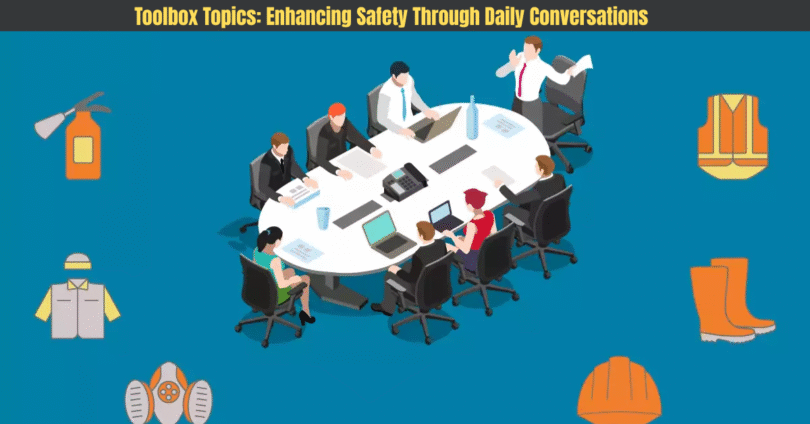In high-risk work environments such as construction, manufacturing, oil and gas, and warehousing, safety is not just a protocol—it’s a culture. One of the most effective ways to reinforce this culture is through Toolbox Topics. These are short, focused safety discussions held regularly—often daily or weekly—before work begins. Toolbox Topics help workers understand safety protocols, recognize hazards, and share best
What Are Toolbox Topics?
Toolbox Topics, also known as Toolbox Talks, Safety Talks, or Tailgate Meetings, are brief meetings (typically 5–15 minutes long) that focus on a specific safety issue. They are usually delivered by a supervisor or safety officer and are designed to:
- Raise safety awareness
- Prevent incidents and injuries
- Encourage open communication about hazards
- Comply with OSHA and company safety requirements
Importance of Toolbox Topics
- Promote a Safety-First Mindset
- Reinforce Company Safety Policies
- Reduce Workplace Accidents
- Comply with OSHA Safety Regulations
- Encourage Worker Participation
- Identify Near-Miss Incidents
- Address Site-Specific Hazards
- Improve Team Communication
- Document Safety Efforts
- Boost Morale and Accountability
Common Toolbox Topic Categories
Toolbox talks can cover a wide range of safety-related topics. Below are the most common categories:
| Category | Example Topics |
| General Safety | Housekeeping, PPE, lifting techniques |
| Electrical Safety | Lockout/tagout, arc flash, extension cord safety |
| Fire Safety | Fire extinguisher use, flammable materials |
| Fall Protection | Ladder safety, harness inspection |
| Chemical Safety | MSDS sheets, handling acids, spill cleanup |
| Tool Safety | Power tool inspection, hand tool handling |
| Environmental Hazards | Heat stress, cold weather, confined spaces |
| Emergency Response | Evacuation plans, CPR basics, first aid kits |
Top 20 Toolbox Topics for 2025
- Slips, Trips, and Falls
- Personal Protective Equipment (PPE)
- Lockout/Tagout (LOTO) Procedures
- Heat Stress Prevention
- Cold Weather Work Safety
- Electrical Hazard Awareness
- Safe Use of Ladders
- Fall Protection Systems
- Fire Prevention and Response
- Chemical Safety and SDS
- Manual Lifting Techniques
- Eye and Face Protection
- Hearing Conservation
- Machine Guarding
- Confined Space Entry
- Scaffold Safety
- Respiratory Protection
- Driving and Vehicle Safety
- First Aid Readiness
- Near-Miss Reporting
How to Conduct an Effective Toolbox Talk
- Plan Ahead: Choose a relevant topic based on job site conditions.
- Keep It Short: 5–15 minutes is ideal.
- Engage Your Team: Ask questions, invite feedback, and use real-world examples.
- Use Visual Aids: Diagrams, photos, or props can reinforce your message.
- Document the Talk: Record the date, topic, attendees, and presenter.
- Follow Up: Apply what was discussed in the actual job environment.
Who Should Deliver Toolbox Topics?
Typically, these talks are led by:
- Site Supervisors
- Safety Officers
- Project Managers
- Team Leads
However, rotating presenters can encourage participation and ownership.
Benefits of Implementing Toolbox Topics Regularly
| Benefit | Impact |
| Improved safety culture | Workers become more safety-conscious |
| Fewer injuries and accidents | Risk identification and mitigation improve |
| Better compliance | Meets OSHA and legal obligations |
| Increased engagement | Workers feel heard and involved |
| Real-time hazard identification | Site-specific risks are addressed quickly |
Challenges and Solutions
| Challenge | Solution |
| Worker disengagement | Make talks interactive and relatable |
| Repetition of topics | Rotate themes and tie into current conditions |
| Time constraints | Schedule talks before shift or during breaks |
| Lack of materials | Use free online resources or safety apps |
Conclusion
Toolbox Topics are a vital component of any proactive safety program. They help reinforce training, reduce incident rates, and build a culture of safety awareness and responsibility. By investing just a few minutes each day, companies can prevent injuries, ensure compliance, and create a safer working environment for everyone.Moreover for further information you may also visit bestsafetyequipments.com
Summary
- Toolbox Topics are brief, focused safety talks delivered regularly.
- They cover a wide range of workplace hazards and prevention strategies.
- Consistent delivery promotes safety, reduces risk, and engages workers.
- Proper planning, interaction, and documentation are key to effectiveness.







